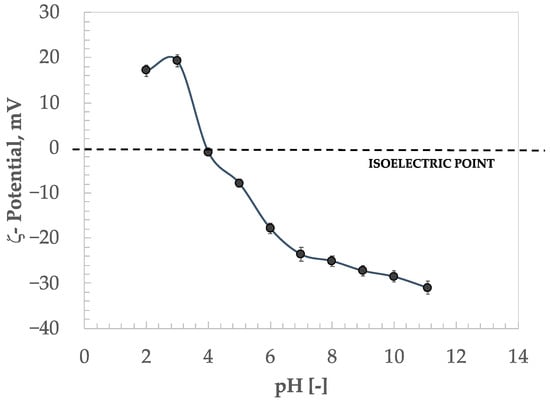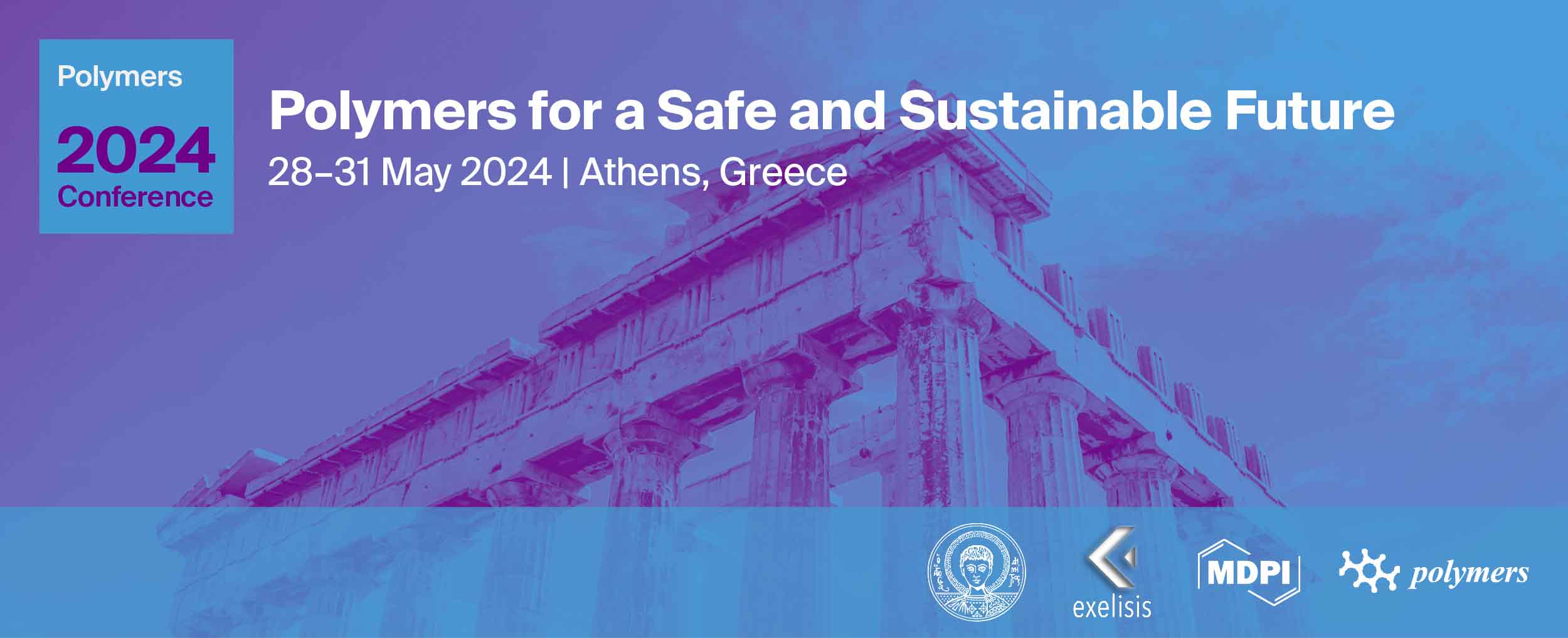Journal Description
Macromol
Macromol
is an international, peer-reviewed, open access journal on all aspects of macromolecular research published quarterly online by MDPI.
- Open Access— free for readers, with article processing charges (APC) paid by authors or their institutions.
- High Visibility: indexed within ESCI (Web of Science), Scopus, CAPlus / SciFinder, and other databases.
- Rapid Publication: manuscripts are peer-reviewed and a first decision is provided to authors approximately 34.7 days after submission; acceptance to publication is undertaken in 6.1 days (median values for papers published in this journal in the second half of 2023).
- Recognition of Reviewers: APC discount vouchers, optional signed peer review, and reviewer names published annually in the journal.
Latest Articles
Dilatational and Shear Interfacial Properties of Pea Protein Isolate Systems with Transglutaminase at the Air–Water Interface
Macromol 2024, 4(2), 227-239; https://doi.org/10.3390/macromol4020012 - 18 Apr 2024
Abstract
►
Show Figures
In recent years, the demand for foods without animal proteins has increased, both for health and ethical reasons. Replacing animal protein in foods can result in unappealing textures, hindering consumer acceptance. In this context, interfacial properties also play a crucial role in food
[...] Read more.
In recent years, the demand for foods without animal proteins has increased, both for health and ethical reasons. Replacing animal protein in foods can result in unappealing textures, hindering consumer acceptance. In this context, interfacial properties also play a crucial role in food systems like foam or emulsions. Therefore, the interfacial rheological behavior at the air–water interface of pea protein isolate (PPI) has been investigated to understand how affects food foam production. The PPI has been studied without modification and also through enzymatic treatment with transglutaminase (TG) to understand the interfacial properties of the modified proteins. Data obtained by static measurements have shown a surface activity of PPI comparable with other vegetable proteins, while the treatment with TG does not significantly alter the surface tension value and the interfacial adsorption rate. Differences have been found in the rearrangement rate, which decreases with TG, suggesting a possible crosslinking of the pea proteins. The PPI modified with TG, studied in dynamic conditions both in dilation and shear kinematics, are less elastic than PPI that is untreated but with a higher consistency, which may lead to poor foam stability. The lower complex interfacial modulus obtained under shear conditions also suggests a low long-time stability.
Full article
Open AccessArticle
Influence of High-Pressure Processing and Microbial Transglutaminase on the Properties of Pea Protein Isolates
by
Rui P. Queirós, Nicole Moreira, Carlos A. Pinto, Liliana G. Fidalgo, Jorge A. Saraiva and José A. Lopes-da-Silva
Macromol 2024, 4(2), 213-226; https://doi.org/10.3390/macromol4020011 - 08 Apr 2024
Abstract
►▼
Show Figures
This study investigated the effects of high-pressure processing (HPP; 600 MPa/15 min) and microbial transglutaminase-catalyzed (MTG; 30 U·g of protein−1) crosslinking on the concentration of dissolved proteins (SOL), free sulfhydryl groups (SH), surface hydrophobicity (H0), and viscosity of
[...] Read more.
This study investigated the effects of high-pressure processing (HPP; 600 MPa/15 min) and microbial transglutaminase-catalyzed (MTG; 30 U·g of protein−1) crosslinking on the concentration of dissolved proteins (SOL), free sulfhydryl groups (SH), surface hydrophobicity (H0), and viscosity of pea protein isolates (PPI) at different concentrations (1–13%; w/v). The SOL increased by increasing protein concentration (max. 29%). MTG slightly affected SOL. HPP decreased SOL with increasing protein concentration, and the combination MTG + HPP resulted in a lower SOL than HPP alone. The concentration of SH in untreated PPI increased with increasing protein concentration, reaching a maximum of 8.3 μmol·mg prot−1. MTG increased SH at higher protein concentrations. HPP lowered SH, but its concentration increased by increasing protein concentration. HPP + MTG offset the effect of MTG, yielding lower SH. MTG did not affect H0 at 1% concentration but increased it for concentrations from 3–5%, and there was a decrease with 7–9%. HPP increased H0 up to 37% for intermediate protein concentrations but did not affect it at higher concentrations. MTG + HPP decreased H0 at all protein concentrations. The viscosity of the dispersions increased with protein concentration. HPP increased the viscosity of the dispersions for concentrations above 7%, while MTG only caused changes above 9%. Combined MTG + HPP resulted in viscosity increase. The results underscore the opportunity for innovative development of high-protein products with improved properties or textures for industrial application.
Full article

Figure 1
Open AccessReview
Bioinspired Polymers: Bridging Nature’s Ingenuity with Synthetic Innovation
by
Hossein Omidian and Niloofar Babanejad
Macromol 2024, 4(2), 190-212; https://doi.org/10.3390/macromol4020010 - 02 Apr 2024
Abstract
►▼
Show Figures
This review delves into the cutting-edge field of bioinspired polymer composites, tackling the complex task of emulating nature’s efficiency in synthetic materials. The research is dedicated to creating materials that not only mirror the strength and resilience found in natural structures, such as
[...] Read more.
This review delves into the cutting-edge field of bioinspired polymer composites, tackling the complex task of emulating nature’s efficiency in synthetic materials. The research is dedicated to creating materials that not only mirror the strength and resilience found in natural structures, such as spider silk and bone, but also prioritize environmental sustainability. The study explores several critical aspects, including the design of lightweight composites, the development of reversible adhesion methods that draw inspiration from nature, and the creation of high-performance sensing and actuation devices. Moreover, it addresses the push toward more eco-friendly material practices, such as ice mitigation techniques and sustainable surface engineering. The exploration of effective energy storage solutions and the progress in biomaterials for biomedical use points to a multidisciplinary approach to surpass the existing barriers in material science. This paper highlights the promise held by bioinspired polymer composites to fulfill the sophisticated needs of contemporary applications, highlighting the urgent call for innovative and sustainable advancements.
Full article
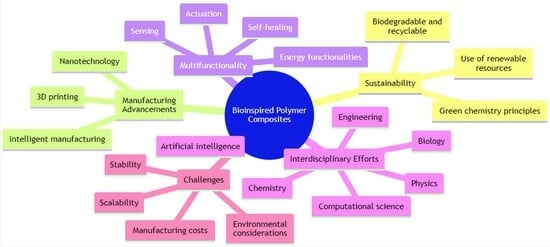
Graphical abstract
Open AccessReview
Mimic miRNA and Anti-miRNA Activated Scaffolds as a Therapeutic Strategy to Promote Bone, Cartilage, and Skin Regeneration
by
Gabriella Guelfi, Camilla Capaccia, Polina Anipchenko, Francesco Ciancabilla, Oommen Podiyan Oommen, Antonello Bufalari, Massimo Zerani and Margherita Maranesi
Macromol 2024, 4(2), 165-189; https://doi.org/10.3390/macromol4020009 - 01 Apr 2024
Abstract
►▼
Show Figures
MiRNA-based therapies represent an innovative and promising strategy applicable to various medical fields, such as tissue regeneration and the treatment of numerous diseases, including cancer, cardiovascular problems, and viral infections. MiRNAs, a group of small non-coding RNAs, play a critical role in regulating
[...] Read more.
MiRNA-based therapies represent an innovative and promising strategy applicable to various medical fields, such as tissue regeneration and the treatment of numerous diseases, including cancer, cardiovascular problems, and viral infections. MiRNAs, a group of small non-coding RNAs, play a critical role in regulating gene expression at the post-transcriptional level and modulate several signaling pathways that maintain cellular and tissue homeostasis. The clinical trials discussed in the review herald a new therapeutic era for miRNAs, particularly in tissue engineering, using synthetic exogenous mimic miRNAs and antisense miRNAs (anti-miRNAs) to restore tissue health. This review provides an overview of miRNAs’ biogenesis, mechanism of action, regulation, and potential applications, followed by an examination of the challenges associated with the transport and delivery of therapeutic miRNAs. The possibility of using viral and non-viral vectors that protect against degradation and ensure effective miRNA delivery is highlighted, focusing on the advantages of the emerging use of 3D biomaterial scaffolds for the delivery of mimic miRNAs and anti-miRNAs to facilitate tissue repair and regeneration. Finally, the review assesses the current landscape of miRNA-activated scaffold therapies on preclinical and clinical studies in bone, cartilage, and skin tissues, emphasizing their emergence as a promising frontier in personalized medicine.
Full article
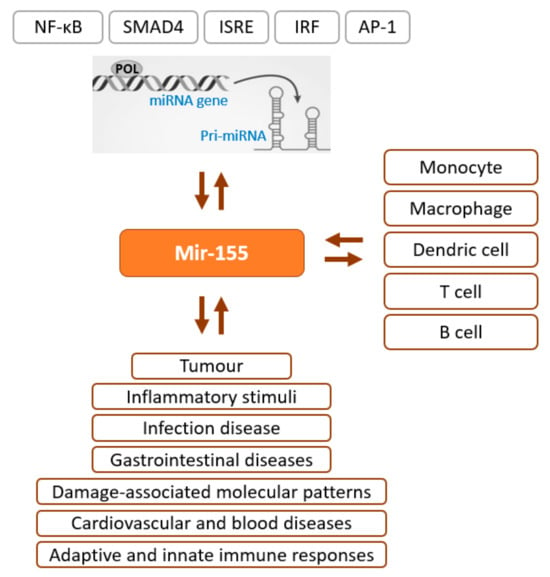
Figure 1
Open AccessArticle
Synthesis and Characterisation of 4D-Printed NVCL-co-DEGDA Resin Using Stereolithography 3D Printing
by
Elaine Halligan, Billy Shu Hieng Tie, Declan Mary Colbert, Mohamad Alsaadi, Shuo Zhuo, Gavin Keane and Luke M. Geever
Macromol 2024, 4(1), 150-164; https://doi.org/10.3390/macromol4010008 - 19 Mar 2024
Abstract
►▼
Show Figures
The design and manufacturing of objects in various industries have been fundamentally altered by the introduction of D-dimensional (3D) and four-dimensional (4D) printing technologies. Four-dimensional printing, a relatively new technique, has emerged as a result of the ongoing development and advancements in 3D
[...] Read more.
The design and manufacturing of objects in various industries have been fundamentally altered by the introduction of D-dimensional (3D) and four-dimensional (4D) printing technologies. Four-dimensional printing, a relatively new technique, has emerged as a result of the ongoing development and advancements in 3D printing. In this study, a stimulus-responsive material, N-Vinylcaprolactam-co-DEGDA (NVCL-co-DEGDA) resin, was synthesised by Stereolithography (SLA) 3D printing technique. The N-Vinylcaprolactam-co-DEGDA resins were initiated by the Diphenyl (2,4,6-trimethylbenzoyl) phosphine oxide (TPO) photoinitiator. A range of Di(ethylene glycol) diacrylate (DEGDA) concentrations in the NVCL-co-DEGDA resin was explored, ranging from 5 wt% to 40 wt%. The structural properties of the 3D printed objects were investigated by conducting Attenuated Total Reflectance–Fourier Transform Infrared Spectroscopy (ATR-FTIR). Additionally, the 3D printed samples underwent further characterisation through differential scanning calorimetry (DSC) and swelling analysis. The results revealed an inverse relationship between DEGDA concentration and Tg values, indicating that higher concentrations of DEGDA resulted in lower Tg values. Additionally, the pulsatile swelling studies demonstrated that increasing DEGDA concentration prolonged the time required to reach the maximum swelling ratio. These findings highlight the influence of DEGDA concentration on both the thermal properties and swelling behaviour of 3D printed samples.
Full article

Figure 1
Open AccessArticle
Black Soldier Fly Larvae Grown on Hemp Fiber: Nutritional Composition and Production of Potential Bioactive Peptides
by
Giulia Leni, Lorenzo Del Vecchio, Claudia Dellapina, Vita Maria Cristiana Moliterni, Augusta Caligiani and Martina Cirlini
Macromol 2024, 4(1), 135-149; https://doi.org/10.3390/macromol4010007 - 16 Mar 2024
Abstract
►▼
Show Figures
Black soldier fly larvae (BSFL) represent a way of converting organic substrates into valuable biomolecules, and are potentially exploitable as feed and food. In the present work, BSFL grown on retted hemp fiber were chemically analyzed to evaluate their nutritional profile. Chemical analysis
[...] Read more.
Black soldier fly larvae (BSFL) represent a way of converting organic substrates into valuable biomolecules, and are potentially exploitable as feed and food. In the present work, BSFL grown on retted hemp fiber were chemically analyzed to evaluate their nutritional profile. Chemical analysis revealed BSFL biomass to be an interesting source of proteins (40% on dry matter) rich in essential amino acids. In addition, larval biomass contained 12% fat, mainly composed of saturated fatty acids, and β-sitosterol and campesterol were found to be the most abundant among sterols. A total of 9% of the larval biomass was composed of chitin. The investigation extended to the enzymatic hydrolysis of proteins, leading to the identification of potential bioactive peptides. Peptidomics analysis coupled with in silico tools unveiled promising antioxidant, ACE-inhibitory, and DPP-IV-inhibitory properties within the protein hydrolysates. These findings revealed the potential of BSFL grown on retted hemp fiber as a source of dietary compounds as well as bioactive molecules which can be exploited as functional ingredients in the feed and food sectors.
Full article
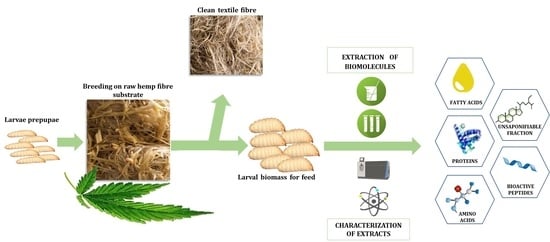
Graphical abstract
Open AccessArticle
Kinetic, Isothermal, and Thermodynamic Analyses of Adsorption of Humic Acid on Quaternized Porous Cellulose Beads
by
Kana Uchiyama, Hiromichi Asamoto, Hiroaki Minamisawa and Kazunori Yamada
Macromol 2024, 4(1), 117-134; https://doi.org/10.3390/macromol4010006 - 05 Mar 2024
Abstract
Porous cellulose beads were quaternized with glycidyltrimethylammonium chloride (GTMAC), and the potential use of the quaternized cellulose beads as an adsorbent was explored for the removal of humic acid (HA) from aqueous media. The introduction of quaternary ammonium groups was verified by FT-IR
[...] Read more.
Porous cellulose beads were quaternized with glycidyltrimethylammonium chloride (GTMAC), and the potential use of the quaternized cellulose beads as an adsorbent was explored for the removal of humic acid (HA) from aqueous media. The introduction of quaternary ammonium groups was verified by FT-IR and XPS analyses, and their content increased to 0.524 mmol/g-Qcell by increasing the GTMAC concentration. The adsorption capacity of the HA increased with decreasing initial pH value and/or increasing content of quaternary ammonium groups, and a maximum adsorption capacity of 575 mg/g-Qcell was obtained for the quaternized cellulose beads with a content of quaternary ammonium groups of 0.380 mmol/g-Qcell. The removal % value increased with increasing dose of quaternized cellulose beads, and HA was highly removed at higher quaternary ammonium groups. The kinetics of the HA adsorption in this study followed a pseudo-second-order equation, and the process exhibited a better fit to the Langmuir isotherm. In addition, the k2 value increased with increasing temperature. These results emphasize that HA adsorption is limited by chemical sorption or chemisorption. The quaternized cellulose beads were repetitively used for the adsorption of HA without appreciable loss in the adsorption capacity. The empirical, equilibrium, and kinetic aspects obtained in this study support that the quaternized cellulose beads can be applied to the removal of HA.
Full article
(This article belongs to the Special Issue Functionalization of Polymers for Advanced Applications)
►▼
Show Figures
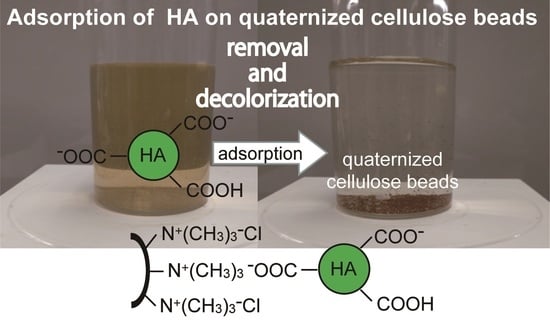
Graphical abstract
Open AccessArticle
Leveraging the Activated Monomer Mechanism to Create Grafted Polymer Networks in Epoxide–Acrylate Hybrid Photopolymerizations
by
Brian F. Dillman, Sage M. Schissel and Julie L. P. Jessop
Macromol 2024, 4(1), 104-116; https://doi.org/10.3390/macromol4010005 - 02 Mar 2024
Abstract
►▼
Show Figures
Hybrid epoxide–acrylate photopolymerization enables the temporal structuring of polymer networks for advanced material properties. The ability to design polymer network architectures and to tune mechanical properties can be realized through the control of the cationic active center propagation reaction (active chain end mechanism)
[...] Read more.
Hybrid epoxide–acrylate photopolymerization enables the temporal structuring of polymer networks for advanced material properties. The ability to design polymer network architectures and to tune mechanical properties can be realized through the control of the cationic active center propagation reaction (active chain end mechanism) relative to the cationic chain transfer reaction (activated monomer mechanism). Grafted polymer networks (GPNs) can be developed through the covalent bonding of epoxide chains to acrylate chains through hydroxyl substituents, making hydroxyl-containing acrylates a promising class of chain transfer agents. This work demonstrates the formation of these GPNs and explores the physical properties obtained through the control of hydroxyl content and hybrid formulation composition. The GPNs exhibit a lower glass transition temperature than the neat epoxide network and result in a more homogeneous network. Further investigations of hydroxyl-containing acrylates as chain transfer agents will generate a wider range of physical property options for photopolymerized hybrid coatings, sealants, and adhesives.
Full article
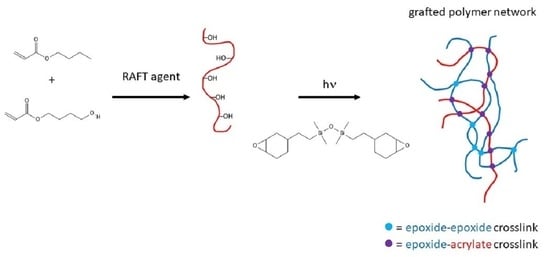
Graphical abstract
Open AccessReview
Electrospinning: Processes, Structures, and Materials
by
Mahboubeh Ahmadi Bonakdar and Denis Rodrigue
Macromol 2024, 4(1), 58-103; https://doi.org/10.3390/macromol4010004 - 11 Feb 2024
Cited by 1
Abstract
►▼
Show Figures
Electrospinning is a simple and affordable method of producing nanofibers, offering a large specific surface area and highly porous structures with diameters ranging from nanometers to micrometers. This process relies on an electrostatic field, providing precise control over the fiber dimensions and morphologies
[...] Read more.
Electrospinning is a simple and affordable method of producing nanofibers, offering a large specific surface area and highly porous structures with diameters ranging from nanometers to micrometers. This process relies on an electrostatic field, providing precise control over the fiber dimensions and morphologies through parameter optimization and the use of specialized spinnerets and collectors. The paper extensively covers the electrospinning process and parameters, shedding light on the factors influencing electrospinning. It addresses the morphological and structural aspects of electrospun fibers that are used in different applications. Additionally, this paper explores various polymeric and non-polymeric materials used in electrospinning. Furthermore, it investigates the incorporation of fillers during electrospinning, using an electric field to enhance properties and functionality. The review concludes by offering insights into upscaling electrospinning production.
Full article
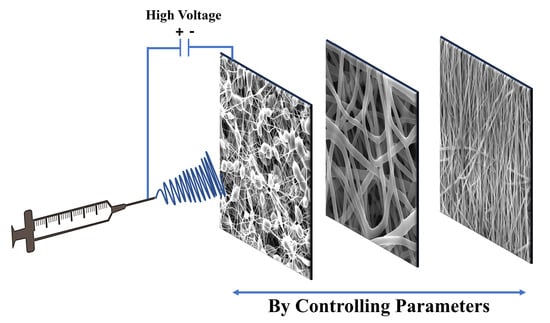
Graphical abstract
Open AccessArticle
Structural Characteristics and Improved Thermal Stability of HDPE/Calcium Pimelate Nanocomposites
by
Christina Samiotaki, Evangelia Tarani, Dimitra Karavasili, Alexandra Zamboulis, Konstantinos Chrissafis and Dimitrios N. Bikiaris
Macromol 2024, 4(1), 42-57; https://doi.org/10.3390/macromol4010003 - 05 Feb 2024
Abstract
►▼
Show Figures
In the present research work, calcium pimelate (CaPim) was synthesized and investigated as an additive for high-density polyethylene (HDPE). HDPE/CaPim nanocomposites were prepared by melt-mixing, with CaPim content ranging from 0.1% to 1%, affording white homogeneous materials. The chemical structure of the nanocomposites
[...] Read more.
In the present research work, calcium pimelate (CaPim) was synthesized and investigated as an additive for high-density polyethylene (HDPE). HDPE/CaPim nanocomposites were prepared by melt-mixing, with CaPim content ranging from 0.1% to 1%, affording white homogeneous materials. The chemical structure of the nanocomposites and the incorporation of CaPim was confirmed by infrared spectroscopy. The surficial morphology and the additive distribution were examined by scanning electron microscopy. Differential scanning calorimetry and X-ray diffraction measurements showed that the thermal transitions and crystal structure of HDPE are not affected by the incorporation of CaPim, while the mechanical properties are retained overall. This study focuses on the thermal degradation of HDPE nanocomposites, investigating the degradation mechanism and kinetic parameters through various analytical methods. Isoconversional techniques, including the Friedman method, Vyazovkin analysis, and Ozawa Flynn Wall analysis, were employed to calculate activation energies (Eα). The degradation mechanism and kinetic triplet were determined based on a multivariate non-linear regression method (model-fitting). Finally, the presence of a CaPim additive was shown to increase the Eα of thermal degradation, consistent with the calculated dependence of Eα on the degree of conversion and the improved thermal stability of the HDPE matrix.
Full article
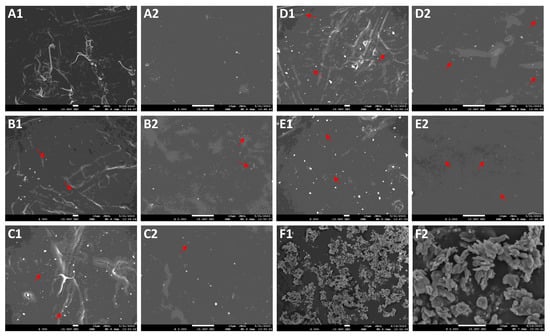
Figure 1
Open AccessReview
Plant-Based Proteins and Their Modification and Processing for Vegan Cheese Production
by
Jelica Kovačević, Thomas Bechtold and Tung Pham
Macromol 2024, 4(1), 23-41; https://doi.org/10.3390/macromol4010002 - 26 Jan 2024
Abstract
►▼
Show Figures
Plant-based proteins are important macronutrients in the human diet, crucial for cell development in our bodies and for supporting the immune system. Given their nutritional and functional properties, plant-based proteins are excellent candidates for the development of plant-based food. Among other things, plant-based
[...] Read more.
Plant-based proteins are important macronutrients in the human diet, crucial for cell development in our bodies and for supporting the immune system. Given their nutritional and functional properties, plant-based proteins are excellent candidates for the development of plant-based food. Among other things, plant-based cheese has been identified as a potential enabler for future innovation through improvements in ingredient technology. Unlike traditional dairy cheeses, plant-based cheeses are made from a variety of ingredients such as nuts and legumes that can be fortified with nutrients also found in traditional cheese. Of course, plant-based cheeses still have some nutritional drawbacks, and most of them are processed, which means they contain preservatives, colour additives and high sodium content. Nevertheless, the physicochemical and functional properties of plant-based proteins are of great interest to the food industry and the initial interest in natural sources of plant proteins has recently shifted to the field of modification and processing. This review discusses the natural sources and classification of plant-based proteins and summarises recent studies on processing methods in the production of plant-based cheese.
Full article
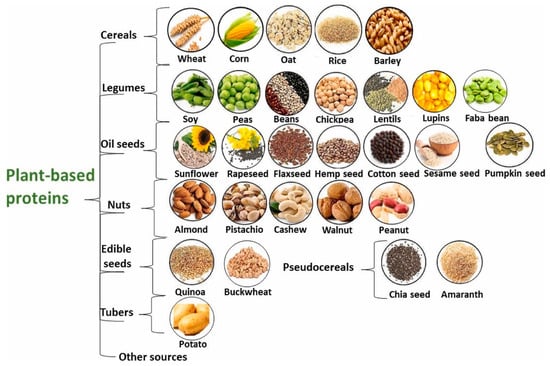
Figure 1
Open AccessArticle
Simple One–Pot Synthesis of Hexakis(2-alkoxy-1,5-phenyleneimine) Macrocycles by Precipitation–Driven Cyclization
by
Toshihiko Matsumoto
Macromol 2024, 4(1), 1-22; https://doi.org/10.3390/macromol4010001 - 03 Jan 2024
Abstract
►▼
Show Figures
Hexakis(2-alkoxy-1,5-phenyleneimine) macrocycles were synthesized using a simple one-pot procedure through precipitation-driven cyclization. The acetal-protected AB–type monomers, 2-alkoxy-5-aminobenzaldehyde diethyl acetals, underwent polycondensation in water or acid-containing tetrahydrofuran. The precipitation–driven cyclization, based on imine dynamic covalent chemistry and π–stacked columnar aggregation, played a decisive role
[...] Read more.
Hexakis(2-alkoxy-1,5-phenyleneimine) macrocycles were synthesized using a simple one-pot procedure through precipitation-driven cyclization. The acetal-protected AB–type monomers, 2-alkoxy-5-aminobenzaldehyde diethyl acetals, underwent polycondensation in water or acid-containing tetrahydrofuran. The precipitation–driven cyclization, based on imine dynamic covalent chemistry and π–stacked columnar aggregation, played a decisive role in the one–pot synthesis. The progress of the reaction was analyzed using MALDI–TOF mass spectrometry. The macrocycles with alkoxy chains were soluble in specific organic solvents, such as chloroform, allowing their structures to be analyzed using NMR. The shape-anisotropic, nearly planar, and shape-persistent macrocycles aggregated into columnar assemblies in polymerization solvents, driven by aromatic π-stacking. The octyloxylated macrocycle OcO–Cm6 exhibited an enantiotropic columnar liquid crystal-like mesophase between 165 °C and 197 °C. In the SEM image of (S)-(–)-3,7-dimethyloctyloxylated macrocycle (–)BCO–Cm6, columnar substances with a diameter of 200–300 nm were observed. The polymerization solution for the 2-(2-methoxyethoxy)ethoxy)ethoxylated macrocycle (TEGO–Cm6) gelled, and showed thixotropic properties by forming a hydrogen bond network.
Full article

Figure 1
Open AccessArticle
Molecular Mechanisms of Protein–Lipid Interactions and Protein Folding of Heterogeneous Amylin and Tau Oligomers on Lipid Nanodomains That Link to Alzheimer’s
by
Natalia Santos, Luthary Segura, Amber Lewis, Thuong Pham and Kwan H. Cheng
Macromol 2023, 3(4), 805-827; https://doi.org/10.3390/macromol3040046 - 15 Dec 2023
Cited by 1
Abstract
►▼
Show Figures
The disruption of cell membranes by tau and amylin oligomers is linked to amyloid diseases such as Alzheimer’s and diabetes, respectively. The recent studies suggest that misfolded tau and amylin can form neurotoxic hetero-oligomers that are structurally different from homo-oligomers. However, the molecular
[...] Read more.
The disruption of cell membranes by tau and amylin oligomers is linked to amyloid diseases such as Alzheimer’s and diabetes, respectively. The recent studies suggest that misfolded tau and amylin can form neurotoxic hetero-oligomers that are structurally different from homo-oligomers. However, the molecular interactions of these hetero-oligomers with the neuronal membranes remain unclear. Using MD simulations, we have investigated the binding behaviors, membrane disruption, and protein folding of hetero-oligomers on a raft membrane containing phase-separated lipid nanodomains like those found in neurons. We discovered that the hetero-oligomers bind to the liquid-order and liquid-disorder phase boundaries of the raft membrane. The major lipid-binding sites of these interactions include the L16 and I26 residues of amylin and the N-terminal of tau. Strong disruptions of the raft domain size by the hetero-tetramer were detected. Furthermore, the hetero-dimer disrupted the saturated phospholipid orientational order to a greater extent than the individual tau or amylin monomer. In addition, the constituent tau more strongly promoted the alpha-helix to the beta-sheet transition of the constituent amylin within the hetero-dimer when compared with the amylin monomer alone. Our results provide new molecular insights into understanding the neurotoxicity of the hetero-oligomers associated with the cross-talk between amyloid diseases.
Full article
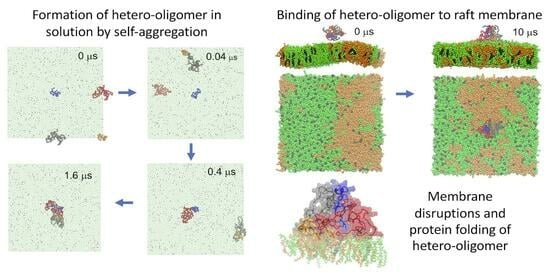
Graphical abstract
Open AccessReview
Polymer Bead Foams: A Review on Foam Preparation, Molding, and Interbead Bonding Mechanism
by
Junjie Jiang, Liang Wang, Fangwei Tian, Yaozong Li and Wentao Zhai
Macromol 2023, 3(4), 782-804; https://doi.org/10.3390/macromol3040045 - 01 Dec 2023
Abstract
►▼
Show Figures
The diverse physical appearances and wide density range of polymer bead foams offer immense potential in various applications and future advancements. The multiscale and multilevel structural features of bead foams involve many fundamental scientific topics. This review presents a comprehensive overview of recent
[...] Read more.
The diverse physical appearances and wide density range of polymer bead foams offer immense potential in various applications and future advancements. The multiscale and multilevel structural features of bead foams involve many fundamental scientific topics. This review presents a comprehensive overview of recent progress in the preparation and molding techniques of bead foams. Firstly, it gives a comparative analysis on the bead foam characteristics of distinct polymers. Then, a summary and comparison of molding techniques employed for fabricating bead foam parts are provided. Beyond traditional methods like steam-chest molding (SCM) and adhesive-assisted molding (AAM), emerging techniques like in-mold foaming and molding (IMFM) and microwave selective sintering (MSS) are highlighted. Lastly, the bonding mechanisms behind these diverse molding methods are discussed.
Full article
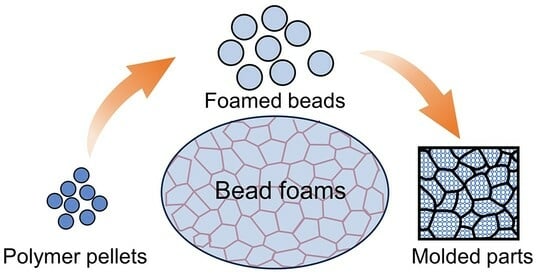
Graphical abstract
Open AccessArticle
Microwave-Assisted Chemical Purification and Ultrasonication for Extraction of Nano-Fibrillated Cellulose from Potato Peel Waste
by
Mohsen Sadeghi-Shapourabadi, Said Elkoun and Mathieu Robert
Macromol 2023, 3(4), 766-781; https://doi.org/10.3390/macromol3040044 - 22 Nov 2023
Cited by 1
Abstract
Nanofibrillated cellulose was extracted from potato peel waste using a fast and green method with a simple process. To extract cellulose and eliminate non-cellulosic constituents, alkaline and hydrogen peroxide treatments were performed under microwave irradiation. The nanofibrillated cellulose was extracted from purified cellulose
[...] Read more.
Nanofibrillated cellulose was extracted from potato peel waste using a fast and green method with a simple process. To extract cellulose and eliminate non-cellulosic constituents, alkaline and hydrogen peroxide treatments were performed under microwave irradiation. The nanofibrillated cellulose was extracted from purified cellulose via TEMPO oxidation followed by ultrasonication. The TEM, FTIR, XRD, and TGA experiments were used to evaluate the structural, crystalline, and thermal properties of cellulose fiber and nanofiber. The chemical and FTIR analysis of bleached fibers indicates that almost all non-cellulosic components of biomass have been eliminated. The diameter of the extracted nanofibers is in the range of 4 to 22 nm. In terms of crystallinity, extracted nanocellulose had 70% crystallinity, compared to 17% for unprocessed lignocellulose fibers, which makes it an excellent choice for use as a reinforcement phase in biobased composites. Thermogravimetric analysis reveals that cellulose nanofibers are less thermally stable than potato peel pure cellulose, but it has a higher char content (28%) than pure cellulose (6%), which signifies that the carboxylate functionality acts as a flame retardant. The comparison between cellulose derived from microwave and conventional extraction methods confirmed that their impact on the removal of non-cellulosic materials is nearly identical.
Full article
(This article belongs to the Topic Cellulose and Cellulose Derivatives)
►▼
Show Figures
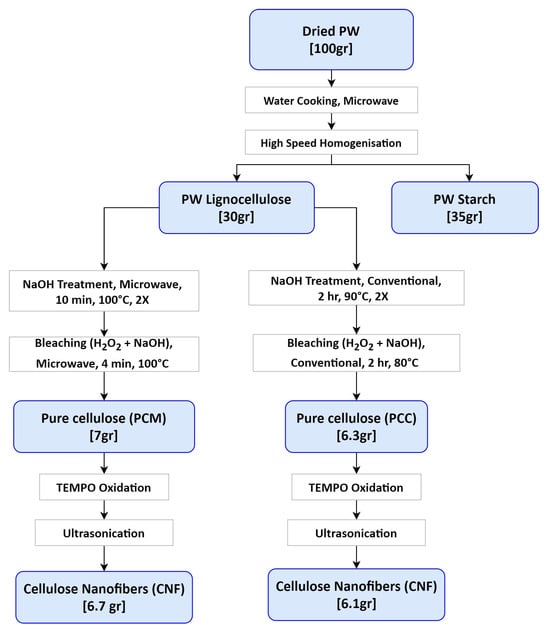
Figure 1
Open AccessArticle
Recycling of Wood–Plastic Composites—A Reprocessing Study
by
Christoph Burgstaller and Károly Renner
Macromol 2023, 3(4), 754-765; https://doi.org/10.3390/macromol3040043 - 02 Nov 2023
Abstract
Wood–plastic composites, consisting of wood particles and a thermoplastic matrix, are common composites often used in buildings as decking boards or for similar non-load-carrying applications. As these are usually semi-finished products, a certain amount of material is available after cutting these to size,
[...] Read more.
Wood–plastic composites, consisting of wood particles and a thermoplastic matrix, are common composites often used in buildings as decking boards or for similar non-load-carrying applications. As these are usually semi-finished products, a certain amount of material is available after cutting these to size, in the factory and also at installation sites. Especially for in-house waste streams in factories, the question remains whether these materials can be reprocessed without any negative influence on the materials’ properties. Therefore, the aim of this work is to investigate the influence of reprocessing on the property profile of polypropylene based wood–plastic composites. Two base formulations with 40 wt% of wood particles and two different polypropylene grades were investigated for their mechanical properties, wood particle size, color, weathering stability and water uptake. We found that most of the wood–plastic composites’ properties were not negatively influenced by the multiple processing steps; the most pronounced effect beside particle size reduction is color degradation, as the composites darken with increasing number of processing steps. In our opinion this shows, that wood–plastic composites can be recycled, especially if these are only reprocessed in smaller shares together with virgin materials.
Full article
(This article belongs to the Special Issue Sustainable Processes to Multifunctional Bioplastics and Biocomposites)
►▼
Show Figures

Figure 1
Open AccessArticle
Preparation of Polyurethane–Urea Fibers with Controlled Surface Morphology via Gel State
by
Yutaka Ohsedo and Honoka Murata
Macromol 2023, 3(4), 742-753; https://doi.org/10.3390/macromol3040042 - 21 Oct 2023
Abstract
►▼
Show Figures
It is widely known that skin irritation can be induced by interactions between polymer fibers constituting clothing and the skin, leading to skin inflammation and unfavorable dermatological reactions. Thus, significant endeavors have been directed toward ameliorating this phenomenon. This study engineered synthetic fibers
[...] Read more.
It is widely known that skin irritation can be induced by interactions between polymer fibers constituting clothing and the skin, leading to skin inflammation and unfavorable dermatological reactions. Thus, significant endeavors have been directed toward ameliorating this phenomenon. This study engineered synthetic fibers with reduced potential for skin irritation. This was achieved via a strategy inspired by the inherent smoothness of silk fibers, which exhibit minimal friction and irritation against the skin. This investigation focused on urethane fibers, a class of synthetic fibers frequently used in textile applications. Hydrogel cross-linked polyurethane–urea fibers were subjected to controlled swelling in different hydrophilic mixed-solvent environments. Subsequent freeze-drying procedures were employed to yield fibers with diverse surface morphologies and encompassing features such as elevations and creases. The correlation between the compositions of the solvent mixtures used and the resulting surface morphologies of the fibers was rigorously assessed through polarized light and scanning electron microscopies. Additionally, the interplay between the degree of swelling and the tensile strength of the fabricated fibers was comprehensively analyzed. Consequently, the methodological combination of swelling and freeze-drying endowed the polyurethane–urea fibers with various surface profiles. Future studies will delve into the intricate connection between fiber surface characteristics and their potential to induce skin irritation. It is envisaged that such investigations will substantially contribute to the refinement of textile fibers designed for enhanced compatibility with the skin.
Full article

Figure 1
Open AccessArticle
Fully Biodegradable Edible Packaging Foils on the Basis of Potato Starch–Lipid–Protein Ternary Complexes
by
Agnieszka Folentarska, Anna Kulakowska, Volodymyr Pavlyuk, Magdalena Krystyjan, Piotr Tomasik and Wojciech Ciesielski
Macromol 2023, 3(4), 723-741; https://doi.org/10.3390/macromol3040041 - 19 Oct 2023
Abstract
►▼
Show Figures
Fully biodegradable foils were prepared from potato starch, egg albumin, and either stearic or oleic acid. Foils prepared with oleic acid have higher tensile strength, relative elongation, thermal stability, and a more uniform macrostructure. Foils produced with stearic acid were characterized by a
[...] Read more.
Fully biodegradable foils were prepared from potato starch, egg albumin, and either stearic or oleic acid. Foils prepared with oleic acid have higher tensile strength, relative elongation, thermal stability, and a more uniform macrostructure. Foils produced with stearic acid were characterized by a higher index of crystallinity than foils made with oleic acid. Functional properties of the foils can be modulated involving a sequence of blending of their components. The simultaneous blending of starch (10 weight parts of 5% aq. gel), albumin (1 weight part of liquid composed of 1 g of albumin in 7 mL of water), and stearic acid (5 weight parts of powder) provided the foil with the highest tensile strength (64.91 MPa/mm). Independently of the method of preparation, foils were white with a greenish-yellow shade. Analysis of the ATR-FTIR spectra showed that the macrostructure of the foils is built involving interactions between all three components.
Full article
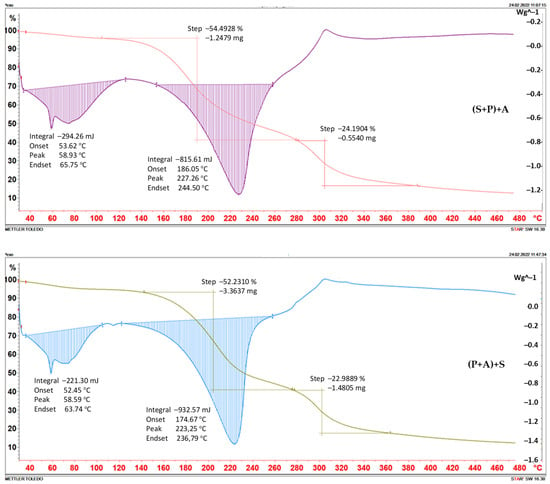
Figure 1
Open AccessArticle
Sustainable Food Packaging with Chitosan Biofilm Reinforced with Nanocellulose and Essential Oils
by
Sofia J. Silva, Nsevolo Samba, José Mendes, João R. A. Pires, Carolina Rodrigues, Joana Curto, Arlindo Gomes, Ana Luísa Fernando and Lúcia Silva
Macromol 2023, 3(4), 704-722; https://doi.org/10.3390/macromol3040040 - 10 Oct 2023
Abstract
Active packaging with biobased polymers aim to extend the shelf life of food and to improve the environmental sustainability of the food industry. This new concept was tested with samples of fresh poultry meat wrapped with chitosan reinforced with 2.5% of commercial nanocellulose
[...] Read more.
Active packaging with biobased polymers aim to extend the shelf life of food and to improve the environmental sustainability of the food industry. This new concept was tested with samples of fresh poultry meat wrapped with chitosan reinforced with 2.5% of commercial nanocellulose (NC) incorporating 1% of essential oils (EO) from Aloysia citrodora (ACEO) and Cymbopogon citratus (CCEO). The performance of the bionanocomposites containing EOs was assessed and compared with unwrapped meat samples and samples wrapped with chitosan/NC, during a 13 day period of refrigerated storage for several physicochemical parameters related to food deterioration and microbial growth. Wrapping the meat with the chitosan/NC polymer helped to increase the shelf life of the meat. The incorporation of EOs added extra activity to the biocomposites, further delaying the meat deterioration process, by halting the lipid oxidation and the Enterobactereaceae growth until the 9th day. The composition of both EOs was similar, with the main components contributing to the increased activity of the biopolymers being geranial and neral. The performance of ACEO surpassed that of CCEO, namely on the Enterobactereaceae growth. This trend may be associated with ACEO’s higher phenolic content and the higher antioxidant activity of the compounds released by the ACEO biopolymers.
Full article
(This article belongs to the Special Issue Functional Polymer-Based Materials)
►▼
Show Figures
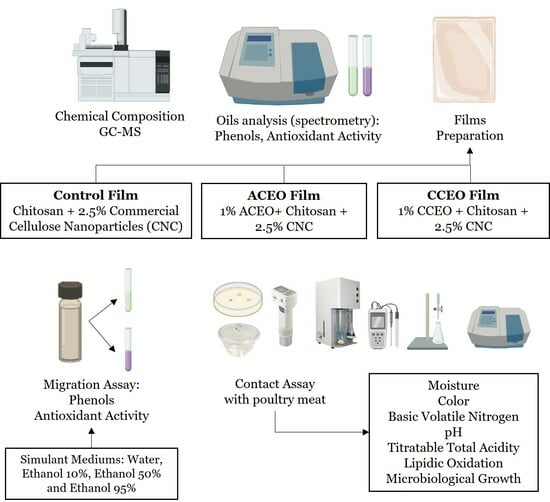
Graphical abstract
Open AccessArticle
Stability Aspects of UV-Curable Prints on Pressure-Sensitive Labels Facestock Made from Agro-Industrial By-Products
by
Ivan Malenica, Marina Golik Krizmanić, Marina Vukoje, Rahela Kulčar and Katarina Itrić Ivanda
Macromol 2023, 3(4), 693-703; https://doi.org/10.3390/macromol3040039 - 07 Oct 2023
Cited by 1
Abstract
►▼
Show Figures
During its life cycle, packaging comes into contact with various substances and even those it protects. Thus, for example, oil, water, and alcohol, if spilled on the packaging, can damage its functionality. In addition to exposure to chemicals, graphic products (packaging) can be
[...] Read more.
During its life cycle, packaging comes into contact with various substances and even those it protects. Thus, for example, oil, water, and alcohol, if spilled on the packaging, can damage its functionality. In addition to exposure to chemicals, graphic products (packaging) can be exposed to moisture and UV radiation, which can negatively affect their stability during transport, storage, and handling. The choice of printing substrate can directly affect the stability of prints against different degrading influences. This paper explores the stability of thermochromic (TC) and conventional offset printing inks printed on environmentally friendly printing substrates intended for packaging applications (labelling). Results have confirmed that used printing substrates and printing inks give prints good rub resistance, but somewhat lower stability in terms of ethanol, water, and UV radiation. The choice of printing substrate can directly affect the stability of prints against different degrading influences. The resistance of prints to oil cannot be clearly defined since the samples were altered with the coloration of the oil. It can only be stated that oil reduced the functionality of the TC prints given that the samples were colored by the oil itself.
Full article
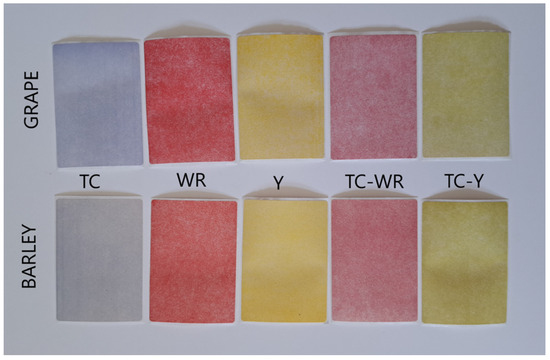
Figure 1
Highly Accessed Articles
Latest Books
E-Mail Alert
News
Topics
Topic in
Biomedicines, JNT, Pharmaceutics, Macromol
Applications of Polymers and Polymer Nanomaterials in Drug Delivery and Nanomedicine
Topic Editors: Stanislav Rangelov, Emi HaladjovaDeadline: 31 May 2024
Topic in
Polymers, Nanomaterials, Molecules, Chemistry, Macromol
Conjugated Polymers: Preparation, Properties and Applications
Topic Editors: Carmine Coluccini, Paolo CoghiDeadline: 31 October 2024
Topic in
Macromol, Molecules, Nanomaterials, Pharmaceutics, Polymers
Advances in Controlled Release and Targeting of Drugs
Topic Editors: Carmine Coluccini, Paolo Coghi, Xingxing FanDeadline: 20 March 2025

Conferences
Special Issues
Special Issue in
Macromol
Sustainable Processes to Multifunctional Bioplastics and Biocomposites
Guest Editor: Valentina SessiniDeadline: 15 November 2024
Topical Collections
Topical Collection in
Macromol
Advances in Biodegradable Polymers
Collection Editor: Dimitrios Bikiaris


